How Crusades-era literature shaped the idea of the Christian West
Jay Rubinstein places himself in the apocalyptic mindset of authors like Joachim of Fiore.
By their own lights, the Crusades were remarkably successful. In a series of military struggles that had the church’s blessing, armed expeditions extended and reinforced the influence of Latin Catholic Christianity and of the Catholic Church. They conquered Muslim kingdoms in Spain and Sicily, subjugated pagan realms in the Baltic lands, and smashed heretical movements in southern France. For each outburst of militant zeal, warriors expected to receive all the spiritual benefits they would have received had they traveled to Jerusalem.
Jerusalem, however, was the Crusades’ one region of conspicuous failure. Christian forces could hold neither that holy city nor the territorial footholds they had secured throughout the Levant. In a brilliant and thoughtful book, Jay Rubenstein shows how that exception proved important to Latin Christian Europe and traces the legacy of that searing disappointment.
Those of us who grew up in the 1960s reading books like Norman Cohn’s The Pursuit of the Millennium (1957) learned about the apocalyptic and millenarian impulses that lay just below the surface of popular thought throughout the Middle Ages, and which found eloquent expression during times of Crusading zeal. Among other things, it was a sense of cosmic war and imminent apocalypse that turned many Christians against those communities they saw as God’s visible enemies in their midst—the Jews, above all.






